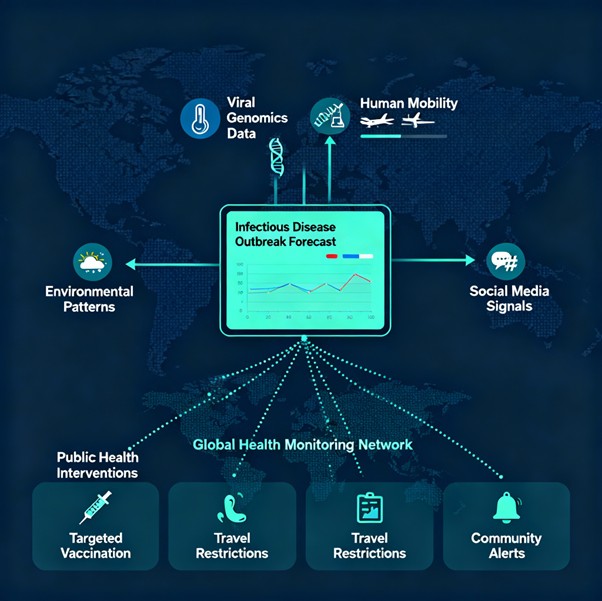AI Predicts Parkinson’s Before Symptoms: Revolutionary Early Detection Systems Achieve >90% Accuracy Years Before Disease Onset
Parkinson’s disease, the second most common neurodegenerative disorder affecting nearly 10 million people worldwide, has long challenged medical professionals with its delayed diagnosis—typically occurring only after 60-80% of dopamine-producing neurons have already been lost. However, revolutionary advances in artificial intelligence are transforming this paradigm by enabling accurate prediction of Parkinson’s disease up to 15 years before symptoms emerge. A groundbreaking AI blood test achieved 96% accuracy in predicting Parkinson’s onset 15 years in advance, while smartwatch-based AI algorithms detected subtle movement changes up to 7 years before clinical diagnosis. These breakthrough technologies represent a fundamental shift from reactive to predictive medicine, opening unprecedented opportunities for neuroprotective interventions during the crucial presymptomatic window.

The Critical Window for Intervention
Traditional Parkinson’s diagnosis relies on the emergence of cardinal motor symptoms—tremor, rigidity, bradykinesia, and postural instability—that appear only after substantial and irreversible neuronal damage has already occurred. By the time patients receive a clinical diagnosis, approximately 60-80% of dopamine neurons in the substantia nigra have been destroyed, severely limiting therapeutic options and recovery potential.
The Presymptomatic Challenge
The prodromal or presymptomatic phase of Parkinson’s disease can extend for years or even decades before motor symptoms become apparent. During this critical period, subtle biochemical, structural, and functional changes occur throughout the nervous system, including:
- Protein aggregation: Alpha-synuclein accumulation begins decades before symptom onset
- Neuroinflammation: Microglial activation and inflammatory processes accelerate neurodegeneration
- Mitochondrial dysfunction: Energy metabolism deficits impair cellular function
- Connectivity disruption: Neural network integrity gradually deteriorates
- Subtle motor changes: Microscopic movement alterations precede obvious symptoms
AI systems excel at detecting these early pathological signatures that remain invisible to conventional clinical assessment methods.
Breakthrough AI Detection Technologies
Blood-Based AI Biomarker Discovery
The most remarkable breakthrough comes from AI-powered blood test development that can predict Parkinson’s disease with extraordinary accuracy years before symptom onset:
15-Year Prediction Capability: Researchers developed an AI tool analyzing blood samples that achieved 96% accuracy in predicting Parkinson’s disease up to 15 years before symptom onset. This revolutionary approach leverages machine learning algorithms to identify subtle protein patterns and biomarker combinations that indicate early disease processes.
7-Year Blood Test Validation: A separate study by UCL and University Medical Center Goettingen created a blood test using artificial intelligence that predicts Parkinson’s up to 7 years before symptom onset. The research team correctly predicted 16 patients who subsequently developed Parkinson’s disease by analyzing 8 specific blood proteins linked to inflammation and protein degradation processes.
Clinical Validation: The patients were followed for 10 years, and AI predictions matched clinical conversion rates perfectly. The biomarkers identified represent possible targets for new drug treatments, as they directly link to disease processes such as inflammation and dysfunction protein clearance.
Wearable Technology and Movement Analysis
Consumer wearable devices combined with sophisticated AI algorithms are revolutionizing presymptomatic detection:
Smartwatch AI Detection: An artificial intelligence algorithm analyzing motion data from smartwatches detected Parkinson’s disease up to 7 years before symptom onset using data from 104,000 UK Biobank participants. The system identified minute subtle slowing of movements that precede clinical diagnosis while distinguishing Parkinson’s from other conditions like osteoarthritis or normal aging.
Superior Predictive Performance: The smartwatch AI algorithm outperformed genetic tests, blood biochemistry tests, and other conventional predictive methods for identifying future Parkinson’s development. This approach offers low-cost, continuous monitoring that could match patients in early disease stages with clinical trials for emerging treatments.
Advanced Brain Imaging Analysis
Deep learning models analyzing neuroimaging data achieve remarkable accuracy in early Parkinson’s detection:
Multimodal Deep Learning Framework: A comprehensive study using Parkinson’s Progression Markers Initiative (PPMI) database achieved 94.2% accuracy in early-stage detection by combining 3D brain architectures with novel Excitation Network (EN) and Explainable AI techniques. The system demonstrated particular strength in identifying subtle motor fluctuations and predicting treatment response patterns.
Brain Region Identification: Explainable AI methods revealed that successful models focused on brain regions critical to prodromal pathophysiology, including right temporal and left prefrontal areas, while Vision Transformers highlighted lateral ventricles associated with cognitive decline. These findings underscore the potential of specific brain regions as early-stage biomarkers.
MRI-Based Detection: Advanced T1-weighted MRI analysis using automated deep learning achieved classification accuracy up to 98.6% for Parkinson’s detection. The fully automated system processes routine MRI data within one minute to provide accurate diagnostic results, dramatically improving efficiency for clinical practice.
Sophisticated AI Methodologies
Multimodal Data Integration
State-of-the-art AI systems combine multiple data sources for enhanced diagnostic accuracy:
Clinical and Imaging Fusion: Joint co-learning approaches enable end-to-end training of deep neural networks that process both imaging and clinical modalities simultaneously. DenseNet with Excitation Networks showed substantial accuracy increases when supplemented with clinical data compared to single-modality approaches.
Voice Analysis Integration: Machine learning models analyzing voice patterns achieved 95.24% accuracy for Parkinson’s detection using hand-drawn spiral analysis combined with speech biomarkers. Pipeline methods combining multiple algorithms improved performance to 85.09% accuracy for voice-based classification.
Movement Pattern Analysis: Advanced frameworks integrating gait analysis, finger tapping assessments, and handwriting analysis provide comprehensive motor function evaluation. Deep learning models processing multiple motor tasks achieved classification accuracies exceeding 90% across diverse patient populations.
Explainable AI for Clinical Trust
Modern AI systems incorporate explainability features essential for clinical adoption:
Attention Mechanisms: Deep SHAP (Shapley Additive Explanations) visualization shows specific brain regions and biomarkers contributing most to diagnostic predictions. These heat maps demonstrate AI focus on Parkinson’s-relevant anatomical structures, enhancing physician confidence in automated diagnoses.
Feature Importance Analysis: SHAP-based approaches identify crucial biomarkers and risk factors associated with Parkinson’s disease development. This transparency enables better clinical decision-making and personalized treatment strategies.
Clinical Performance Achievements
Comprehensive Systematic Review Results
A systematic review of 127 studies spanning 2018-2024 demonstrated significant advances in AI-driven Parkinson’s diagnosis, with accuracy rates consistently ranging from 78% to 96%. The analysis revealed:
Early-Stage Performance: In Stages 1-2 Parkinson’s disease, AI frameworks achieved 92.8% accuracy, demonstrating strong capability to detect subtle symptom manifestations challenging for traditional clinical methods.
Advanced-Stage Excellence: For Stages 3-5 disease, AI models reached 96.1% accuracy, reflecting ability to detect complex symptomatology associated with disease progression.
Multimodal Superiority: Integrated approaches consistently outperformed single-parameter methods by 6-15 percentage points, highlighting the value of comprehensive assessment strategies.

Specialized Detection Approaches
Different AI paradigms demonstrate unique strengths for various aspects of early detection:
DaTscan Analysis: Deep learning models processing DaTscan images achieved 97.3% classification accuracy with 99.6% AUC using neural network classifiers combined with transfer learning. SqueezeNet and VGG-16 architectures demonstrated superior performance for this dopamine transporter imaging analysis.
EEG Signal Processing: AI models analyzing EEG signals achieved 85% sensitivity and 79.4% specificity for early-stage Parkinson’s detection using fNIRS technology. Support Vector Machine models demonstrated highest accuracy among machine learning approaches for brain function analysis.
Motor Symptom Detection: Convolutional neural networks analyzing gait patterns achieved 87.08% accuracy using Gated Recurrent Units optimized by modified Crayfish Optimization Algorithm for freezing of gait episode detection.
Clinical Applications and Implementation
Screening Program Integration
AI-powered early detection systems are being integrated into clinical workflows:
Population Health Screening: Large-scale deployment of wearable-based AI screening could identify at-risk individuals years before symptom onset, enabling participation in neuroprotective clinical trials during the optimal intervention window.
Primary Care Integration: Automated analysis of routine MRI scans, blood tests, and digital biomarkers can flag high-risk patients for specialist referral without requiring specialized neurological expertise at initial screening stages.
Telemedicine Applications: Smartphone-based motor assessments combined with AI analysis enable remote screening capabilities particularly valuable for underserved populations with limited access to specialized neurological care.
Precision Medicine Opportunities
Early AI detection enables personalized intervention strategies:
Risk Stratification: AI models identify patient subgroups with different disease progression trajectories, enabling tailored monitoring and intervention protocols based on individual risk profiles.
Treatment Optimization: Predictive algorithms analyzing treatment response patterns help optimize therapeutic strategies before significant neuronal damage occurs.
Clinical Trial Enrichment: AI-identified presymptomatic patients provide ideal populations for testing neuroprotective therapies that may slow or prevent disease progression.
Challenges and Future Directions
Technical and Clinical Validation
Widespread implementation faces several important challenges:
Generalizability Validation: Models trained on specific populations require validation across diverse ethnic, geographic, and demographic groups to ensure universal applicability and avoid algorithmic bias.
Longitudinal Validation: Long-term prospective studies are essential to confirm AI predictions translate into actual clinical outcomes and treatment benefits.
Standardization Requirements: Harmonization of data collection protocols, imaging parameters, and biomarker measurements across institutions is crucial for reliable multi-center deployment.
Regulatory and Ethical Considerations
Clinical implementation requires addressing complex regulatory and ethical issues:
FDA Approval Pathways: AI diagnostic systems must undergo rigorous regulatory evaluation demonstrating safety, efficacy, and clinical utility for presymptomatic disease detection.
Informed Consent Frameworks: Predicting future disease development raises complex ethical questions about patient autonomy, psychological impact, and insurance implications that require careful consideration.
Healthcare Access Equity: Advanced AI technologies must be implemented in ways that enhance rather than exacerbate healthcare disparities across different socioeconomic and geographic populations.
Future Implications for Neurological Care
Paradigm Shift to Prevention
AI-powered early detection represents a fundamental transformation in neurological medicine:
Neuroprotective Therapy Development: Early identification enables testing of neuroprotective interventions during the critical presymptomatic window when maximal therapeutic benefit may be achievable.
Lifestyle Intervention Optimization: Personalized recommendations for exercise, nutrition, and cognitive training can be tailored based on individual risk profiles and disease progression predictions.
Healthcare Resource Allocation: Predictive screening enables proactive healthcare planning and resource allocation based on anticipated disease burden and intervention requirements.
Integration with Emerging Therapies
AI detection systems will integrate with next-generation Parkinson’s treatments:
Gene Therapy Applications: Early identification of genetic risk factors enables targeted gene therapy interventions before irreversible neuronal damage occurs.
Stem Cell Therapy Optimization: Precise timing of regenerative interventions based on AI-predicted disease progression may maximize therapeutic efficacy.
Digital Therapeutics: Continuous monitoring through AI-enabled devices supports personalized digital interventions and real-time therapy adjustments.
AI Early Detection Timeline for Parkinson’s


Conclusion: Transforming the Future of Parkinson’s Care
AI-powered early detection of Parkinson’s disease represents one of the most transformative advances in modern neurology. By achieving >90% accuracy in predicting disease onset years to decades before symptom emergence, these systems fundamentally change the therapeutic landscape from reactive treatment to proactive prevention.
The convergence of blood-based biomarkers, wearable technology, advanced neuroimaging, and sophisticated machine learning creates unprecedented opportunities for neuroprotective intervention during the critical presymptomatic window. As AI algorithms continue improving and validation studies confirm long-term benefits, these technologies promise to transform Parkinson’s disease from an inevitable neurodegenerative decline to a preventable condition.
The future of Parkinson’s care lies not in managing symptoms after they appear, but in preventing them from developing entirely. Through responsible implementation, continued validation, and equitable access, AI-powered early detection systems will restore hope to millions at risk and fundamentally reshape our approach to neurodegenerative disease prevention and management.
This represents more than technological advancement—it is the dawn of truly predictive, personalized, and preventive neurological medicine that could spare countless individuals and families from the devastating impact of Parkinson’s disease.






